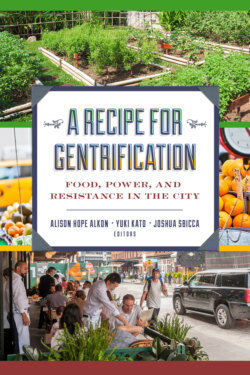Читать книгу A Recipe for Gentrification - Группа авторов - Страница 21
Durham’s Food Scene
ОглавлениеThe Five Points Intersection is the nexus of the redeveloped downtown area and the heart of Durham’s foodie culture. A short walk around this area will take you past some of these businesses and development projects: two tapas restaurants, three buildings under renovation, a newly completed 27-story office and condominium building, three boutique hotels, an expensive clothing store specializing in small-batch production labels, several bars, a pet boutique, a deli, an Italian restaurant, a sandwich shop specializing in Italian-influenced sandwiches, two upscale pizza places, two stores selling African clothing and objects, a vinyl record store, several culturally hybrid restaurants, a café that often offers jazz acts, a cocktail bar, an architect’s office, a book store, and several other establishments. Each of these specializes in high-quality products, aimed at discerning consumers who are willing to pay high prices. By my estimate, all these businesses, with the exception of two or three, have opened since 2008.
The growth of restaurants in the central city (the so-called loop) has been exponential. There are twenty-six restaurants and the average year of opening is 2011, with a continued year-over-year increase in openings since then (City and County of Durham 2017). Restaurants were the first places of consumption that sprouted up in the downtown area. Durham’s redevelopment has been driven by its wealthy residents’ appetites, and the price points are well out of reach of lower-income Durhamites.
Durham’s food scene follows along the gourmet characteristics outlined by Johnston and Baumann (2015): It aims to be authentic and exotic, blending “low-brow” and “high-brow” foods (Peterson and Kern 1996). Foods that were long held in contempt—such as hamburgers, macaroni and cheese, fried chicken, and other staples of American mass cooking—are slowly being embraced in fancier restaurants. Low-brow foods in gourmet restaurants might represent an ethos of tolerance and inclusion, as cultural elites celebrate the contributions of lower-status social groups. The description of the food at the high-priced restaurants in boutique Durham Hotel, operated by a James Beard Award–winning chef, captures this: “The fried chicken is less North Carolina than chic North Carolina hotel. Three iPhone-size pieces of boneless, dark, tender meat come with a beautifully bumpy, shattering crust, more like airy tempura than the standard sturdy coating.… It’s not the Southern fried chicken an out-of-towner might expect” (Laperruque 2015). Indeed, the stereotypically greasy, heavy fried chicken is not to be found. Rather, it is updated with finer cooking techniques and locally sourced ingredients. Such adoption of low-brow foods into high-brow eateries involves the redefinition and reinterpretation of these foods, however, which undermines the idea that there is now a democratic celebration of different cooking traditions. Another observer explicitly states that food itself can be gentrified: “The Durham local food movement is a gentrified version of what used to be Southern food. And that culture is now lost. It’s why we [Black communities] are not involved” (quoted in Bouloubasis 2016).
The process rids the food of its connection to the people and history. Yet, those who produce and consume this gentrified food still make a claim to the cachet of local history and authenticity. The food itself then parallels the redevelopment of the city, as the uses and meanings of old buildings and neighborhoods are being repurposed for new patterns of consumption.
